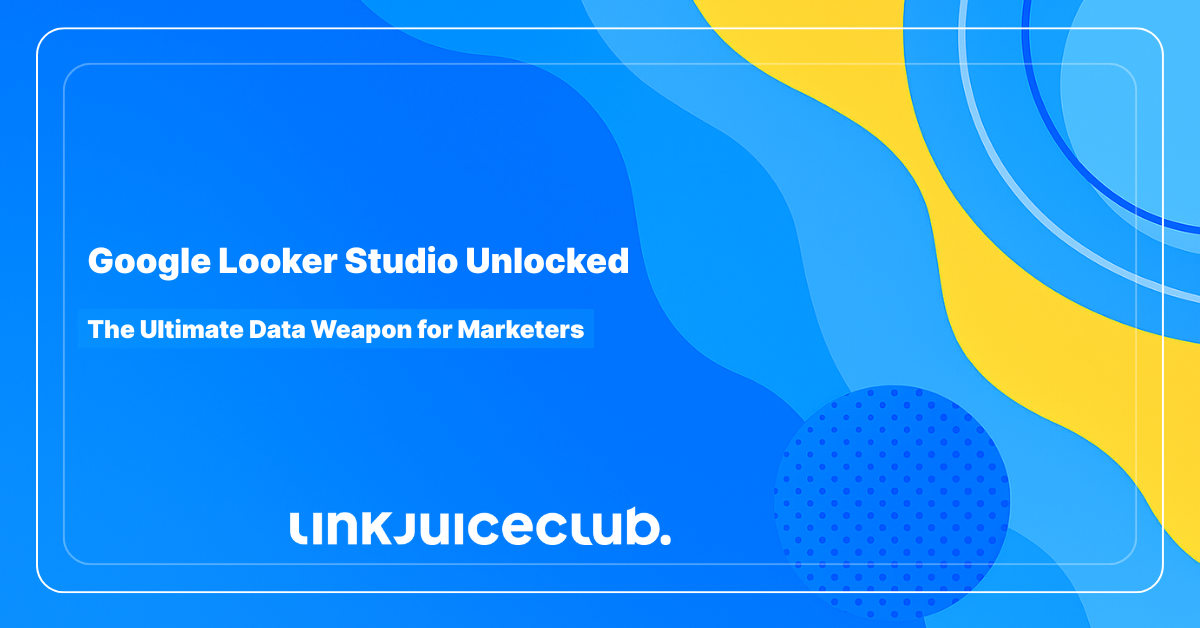
Google Looker Studio Unlocked: The Ultimate Data Weapon for Marketers
If “Google Looker Studio” isn’t already part of your marketing toolbox, you’re not just late to the party — you might be looking at your data with a blindfold on. In a world where dashboards decide direction and insights fuel strategy, this is your backstage pass to see everything clearly.
Ready to turn raw numbers into visual gold? Let’s break it down — no fluff, all flow.
So, What Exactly Is Google Looker Studio?
Think of Google Looker Studio as the control tower of your data airport — guiding insights to land safely, on time, and with purpose. Previously known as Google Data Studio, this tool isn’t just a dashboard. It’s your data’s personal stylist, turning raw, messy numbers into polished, interactive visuals that actually make sense.
📊 Why marketers are flocking to it?
Because it’s not just a “read-only” report card — it’s a playground for exploration:
- Zoom in with filters, drill down like a data detective, or craft custom metrics on the fly
- Pull from multiple sources — MySQL, SQL Server, Google Analytics, you name it
- Snap together campaign data, sales performance, and web traffic into a single, stunning story
Whether you’re pitching to a client or planning your next big move, Looker Studio helps you:
- Track KPIs like a hawk 🦅
- Uncover trends before they become “yesterday’s news”
- Align teams with one visual truth (no spreadsheets in sight)
And the best part? It’s built for everyone — not just the code-slingers.
Drag, drop, click, done. That’s how intuitive it is.
This isn’t just data visualization. It’s marketing with x-ray vision.
Meet the Magic: What Makes Google Looker Studio a Marketer’s Secret Weapon
Now that we’ve set the stage, let’s crack open the toolbox. Because Looker Studio isn’t just pretty charts and slick colors — it’s built to do the heavy lifting while keeping things fun, fast, and functional.
Think of it like giving your data a power suit and a microphone — suddenly it’s not just numbers, it’s telling stories that convert.
Let’s unpack the good stuff:
Seamless Data Integration
No more app-hopping or spreadsheet limbo.
Looker Studio connects to all the usual suspects (and then some):
- Google Analytics, Ads, BigQuery, Google Sheets
- MySQL, PostgreSQL, and other SQL-based systems
- Even cloud platforms and on-prem databases
💡 Third-party connectors? Oh, they open the floodgates.
Whether you’re pulling in Shopify sales or Facebook ad stats — it all comes together under one roof. Fast, flexible, and frictionless.
Custom Dashboards That Flex With You
Your data, your rules. Build reports that actually work for your workflow — no templates from 2009, no rigid layouts.
- Mix & match metrics from different sources
- Use templates or start fresh from a blank canvas
- Add filters to let users explore their own “what-if” scenarios
And yep — you can dial in visuals to match your brand’s vibe:
- Color-code KPIs 🎨
- Drop in logos, headlines, or even custom metrics
- Interactive charts, tables, maps, and more to get the message across
📢 Here’s the kicker: Clients can engage with your dashboards like they’re part of the action. Clickable filters, drill-down options, and real-time updates mean every chart becomes a conversation, not just a screenshot.
Real-Time Collaboration: Teamwork Just Got a Glow-Up
No more email chains, no more “version 17_final_v2.xlsx.”
With Looker Studio, your whole squad can jump into the same report — live.
- Collaborate in real-time, just like a shared Google Doc
- Drop insights, add visuals, make changes — all on the fly
- Set permission levels to keep your data secure while your team works its magic
It’s like a digital war room, minus the chaos.
Interactive Reporting: Don’t Just See Data — Play With It
Static reports are so last decade.
Looker Studio brings clickable curiosity into your dashboards:
- Dive deep with drill-downs 🔍
- Toggle filters to isolate metrics that matter
- Let users explore without breaking your layout
💡 Think of it like a choose-your-own-adventure, but for analytics — the more they interact, the more they understand.
Template Gallery: Pre-Built Power Moves
Just landed on the platform? No worries — Looker Studio rolls out the red carpet with a library of ready-to-roll templates.
- Track website traffic, campaign ROI, sales performance & more
- Customize layouts, metrics, and visuals to fit your exact use case
- Skip the blank page syndrome and start presenting insights in minutes
🚀 Whether you’re a first-timer or a seasoned analyst, templates help you hit the ground running — zero coding, all storytelling.
Why Marketers Swear by Google Looker Studio
This isn’t your average reporting tool — Google Looker Studio is the Swiss Army knife of modern marketing analytics. From tracking conversions to impressing clients, it gives marketers a crystal-clear view of what’s working, what’s wasting budget, and where to aim next.

Let’s unpack why it’s become a must-have in every savvy marketer’s stack:
What Looker Studio Unlocks for Marketers
| 🔥 Feature | 💡 What It Does |
| Unified Data Views | Combine Google Ads, email, SEO, social media — all under one roof |
| Live Metrics at a Glance | Monitor traffic, conversions, ROAS, and CAC in real-time |
| Campaign Optimization | Use actionable insights to pivot strategies instantly |
| Effortless Reporting | Build sleek, client-ready dashboards without technical know-how |
| Automated Workflows | Schedule and generate reports hands-free — while you plan your next move |
| Engaging Interactivity | Let stakeholders explore metrics with filters and drill-downs |
| Stakeholder-Friendly Sharing | Share live links — no more PDFs or outdated slides |
Quick Wins for Your Marketing Team
- Identify budget-draining campaigns before they tank ROI
- Show clients exactly what they’re paying for — in visuals, not jargon
- Make collaboration seamless with real-time access and team editing
- Save hours weekly with pre-set automations and templates
It’s not just data. It’s a performance boost disguised as a dashboard.
A Tour of the Google Looker Studio Homepage
The homepage of Google Looker Studio is more than just a dashboard — it’s mission control. From here, you can manage every report, data source, and spontaneous insight without breaking a sweat.
Let’s break down the core sections that make your workflow actually work:
Reports: Your Data, All in One Place
The “Reports” section is where your masterpieces live. Whether it’s client-facing dashboards or internal strategy boards, this is where you’ll find:
- A list of all your reports, sorted by relevance or last edit
- One-click access to edit, share, or present
- At-a-glance details like name, modification date, and ownership
💡 It’s like a digital bookshelf for your insights — tidy, searchable, and always ready.
Data Sources: The Heartbeat of Your Dashboards
Here’s where your connected platforms come together. Think of this as your data command center:
- View all active connections from platforms like Google Analytics, Ads, Sheets, and SQL databases
- Organize sources by project or team
- Control who sees what with granular access settings
Keeping this clean means your reports pull the right data, every time.
Explorer: Quick Dives, Zero Commitment
Need to test a hypothesis or build a fast chart? Explorer is your sandbox.
- Drag and drop fields to create instant visuals
- Experiment with data without creating a full report
- Ideal for prototyping ideas or spotting early trends
It’s the perfect playground for marketers who think with their mouse and move fast with insights.
How to Use Google Looker Studio: A Step-by-Step Guide
Ready to turn chaos into clarity? Here’s how to go from zero to dashboard hero with Google Looker Studio — no data science degree required.
Let’s break it down:
Step 1: Log Into Looker Studio
- Head over to 👉 datastudio.google.com
- Sign in using your Google account (Gmail, Workspace, etc.)
- Make sure you have the proper permissions to view or edit reports
📌 Once you’re in, the full toolkit is at your fingertips.
Step 2: Start a New Report
- Click “Create” → “Report”
- A blank canvas will open — this is where your masterpiece begins
- New to the platform? Try a template to see best practices in action
📌 Every great dashboard starts with a single click.
Step 3: Add Your Data Sources
- Click “Add Data”
- Choose your data platform: Google Analytics, Ads, Sheets, BigQuery, etc.
- Authenticate with the right credentials (API keys, access tokens, or account permissions)
🎯 Supported data types:
| 🔍 Source Type | Examples |
| Google Tools | GA4, Ads, Search Console, Sheets |
| SQL/Cloud | BigQuery, MySQL, PostgreSQL |
| Third-Party | Facebook, HubSpot, Shopify (via connectors) |
📌 Your dashboard is only as strong as the data behind it.
Step 4: Build & Design Your Dashboard
- Drag & drop charts, tables, maps, and scorecards onto your canvas
- Style it up with custom colors, fonts, and layout themes
- Add filters and controls to let users interact with the data
💣 Pro Tip: Group related elements (like KPIs, traffic, conversions) together — it makes storytelling easier for your viewers.
📌 Make it visual, make it interactive, make it unforgettable.
Step 5: Share, Collaborate & Automate
- Hit “Share” → set permissions: View, Comment, or Edit
- Send the link directly or invite via email
- Set up email schedules to send reports automatically
🎯 Great for:
- Team sync-ups
- Client reporting
- Leadership dashboards
📌 Your data doesn’t live in a silo — and now, neither does your report.
A Look Inside Looker Studio’s Visual Toolbox
Data is only as powerful as the way you show it — and Looker Studio gives you the full paint palette to turn boring stats into “aha!” moments. From crisp comparisons to visual storytelling, there’s a chart for every job.
Let’s break it down chart-by-chart:
Bar Chart: Build Your Data Side-by-Side
Want to compare apples to oranges? Or maybe regional sales vs. traffic sources?
Bar charts are your go-to for crystal-clear category comparisons.
Best for:
- Comparing values across multiple categories
- Visualizing regional performance (e.g., sales by state, traffic by source)
- Showing clear differences at a glance
📌 The longer the bar, the louder the data.
Line Chart: Watch the Journey Unfold
Think of line charts as the storyboards of your data. They’re perfect for showing growth, decline, or that satisfying hockey-stick moment.
Best for:
- Tracking performance over time
- Visualizing campaign progression or trend lines
- Monitoring web traffic or sales growth
📌 Great for spotting momentum — or red flags.
Pie Chart: Show the Whole Pie (and Who’s Eating What)
When you need to show how something is sliced, pie charts are simple, visual, and digestible — just like actual pie.
Best for:
- Displaying percentages of a whole
- Showing market share, user demographics, or traffic split
- Simple, high-level comparisons
📌 Perfect for presentations where clarity matters.
Table: Show Me the Details
Tables are the workhorses of reporting. Less flash, more depth — they lay it all out row by row.
Best for:
- Summarizing granular data
- Displaying KPIs in a digestible format
- Comparing multiple variables in one view
📌 Ideal when stakeholders ask, “Can I see the numbers?”
Scatter Chart: Spot the Spark Between Variables
Want to find out if X is affecting Y? Scatter charts show the relationships that numbers might be hiding.
Best for:
- Revealing correlations between two metrics
- Detecting outliers or trends in large data sets
- Advanced insights and testing hypotheses
📌 Great for analysts, data nerds, and curious minds alike.
Map: Bring Your Data Down to Earth
Where is your traffic coming from? Which regions are buying the most? Let maps turn location data into real-world strategy.
Best for:
- Showing sales, traffic, or performance by location
- Spotting regional patterns
- Geotargeting and local campaign analysis
📌 See your numbers move across the map in real-time.
Scorecard: One Metric to Rule Them All
When one number is all that matters — slap it on a scorecard and make it pop. Big, bold, and impossible to miss.
Best for:
- Highlighting KPIs like revenue, ROI, or engagement
- Keeping dashboards focused
- Executive summaries and client reports
📌 Your “headline stat” deserves the spotlight.
How Looker Studio Supercharges Your Marketing Strategy
Google Looker Studio isn’t just a tool — it’s a marketer’s mission control. It bridges the gap between data and action, giving you clarity, speed, and insights that drive performance.

Here’s how each core function maps directly to real-world marketing power:
From Features to Real Marketing Impact
| 🚀 Feature | 💼 Marketing Power-Up |
| Multi-Channel Data Integration | Get all your campaign data — Google Ads, SEO, social, email — in one place for instant comparison |
| Live Dashboards | See campaign metrics like ROAS, CAC, and CTR in real-time to make timely decisions |
| Scorecards & Visual KPIs | Instantly highlight what matters most to clients and teams without endless explaining |
| Custom Filters & Drilldowns | Explore audience behavior or campaign performance down to the nitty-gritty |
| Templates & Automations | Save time on recurring reports — more strategy, less spreadsheet-wrangling |
| Collaboration & Sharing Tools | Keep clients in the loop and teams aligned with live, editable dashboards |
Why This Matters for Marketers
This isn’t just about pretty charts. It’s about:
- Faster pivots: Stop wasting budget on low performers
- Stronger pitches: Visual proof of ROI, not vague summaries
- Tighter team flow: Everyone’s on the same page, in real time
💡 When your data is this clean and this actionable, strategy becomes obvious — and execution gets way sharper.
Key Takeaways: What Marketers Gain With Google Looker Studio
By now, it’s clear — Google Looker Studio isn’t just a data tool, it’s your competitive edge in a crowded marketing landscape. Whether you’re tracking performance, optimizing spend, or impressing stakeholders, it brings precision and clarity to every click.
Here’s what to remember:
- ✅ All-in-one reporting: Pull from multiple platforms — no more data silos
- ✅ Live dashboards: React to trends and tweak campaigns before they underperform
- ✅ Client-ready visuals: Show value with zero fluff, 100% clarity
- ✅ Time-saving templates: Automate recurring reports and focus on strategy
- ✅ Team collaboration: Everyone sees the same data, at the same time
If you’re ready to stop guessing and start scaling, Looker Studio is the toolkit that turns raw data into real results.





